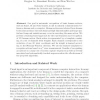Free Online Productivity Tools
i2Speak
i2Symbol
i2OCR
iTex2Img
iWeb2Print
iWeb2Shot
i2Type
iPdf2Split
iPdf2Merge
i2Bopomofo
i2Arabic
i2Style
i2Image
i2PDF
iLatex2Rtf
Sci2ools
117
Voted
ICCV
2005
IEEE
2005
IEEE
3D Human Action Recognition Using Spatio-temporal Motion Templates
Our goal is automatic recognition of basic human actions, such as stand, sit and wave hands, to aid in natural communication between a human and a computer. Human actions are inferred from human body joint motions, but such data has high dimensionality and large spatial and temporal variations may occur in executing the same action. We present a learning-based approach for the representation and recognition of 3D human action. Each action is represented by a template consisting of a set of channels with weights. Each channel corresponds to the evolution of one 3D joint coordinate and its weight is learned according to the Neyman-Pearson criterion. We use the learned templates to recognize actions based on χ2 error measurement. Results of recognizing 22 actions on a large set of motion capture sequences as well as several annotated and automatically tracked sequences show the effectiveness of the proposed algorithm.
Related Content
| Added | 24 Jun 2010 |
| Updated | 24 Jun 2010 |
| Type | Conference |
| Year | 2005 |
| Where | ICCV |
| Authors | Fengjun Lv, Ramakant Nevatia, Mun Wai Lee |
Comments (0)

